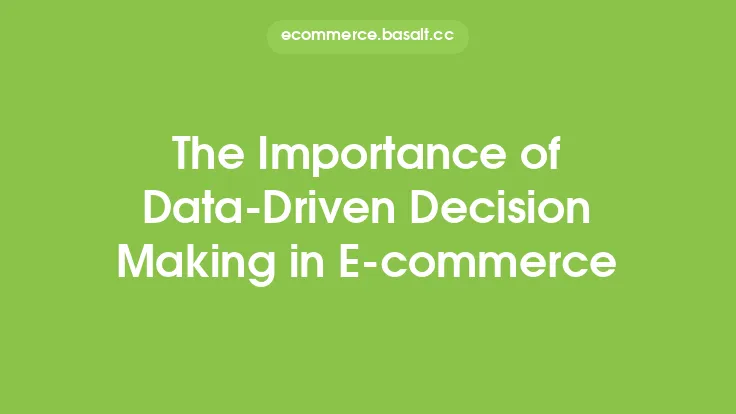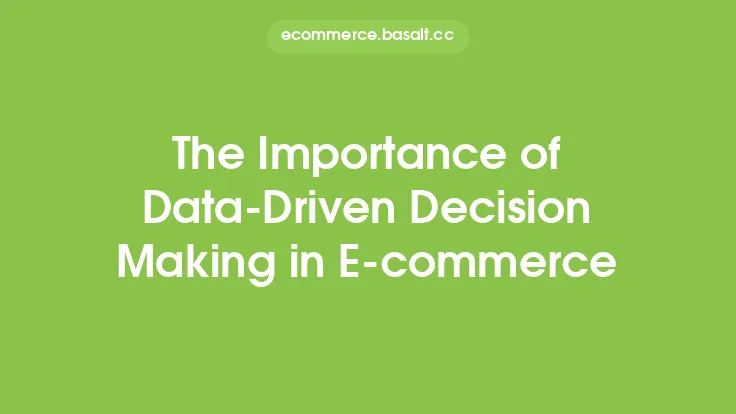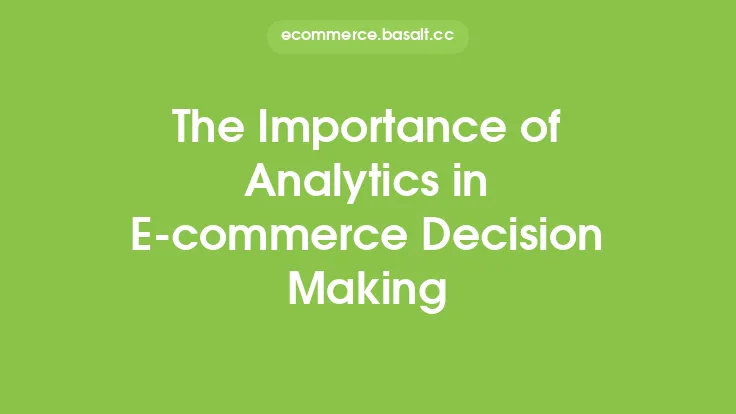In today's fast-paced and competitive e-commerce landscape, making informed decisions is crucial for businesses to stay ahead of the curve. With the vast amount of data available, e-commerce companies can no longer rely on intuition or guesswork to drive their decision-making processes. Instead, they must adopt a data-driven approach to optimize their operations, improve customer experiences, and ultimately drive business growth. Data-driven decision making is a methodology that involves using data and analytics to inform and guide business decisions, rather than relying on personal opinions or biases.
What is Data-Driven Decision Making?
Data-driven decision making is a systematic approach to decision making that involves collecting and analyzing data to identify trends, patterns, and insights. This approach enables e-commerce businesses to make informed decisions that are grounded in reality, rather than relying on assumptions or intuition. By leveraging data and analytics, e-commerce companies can gain a deeper understanding of their customers, markets, and operations, and make decisions that are tailored to their specific needs and goals.
Benefits of Data-Driven Decision Making in E-commerce
The benefits of data-driven decision making in e-commerce are numerous. Some of the most significant advantages include:
- Improved decision making: By using data and analytics to inform decisions, e-commerce businesses can reduce the risk of errors and improve the accuracy of their decision making.
- Enhanced customer experiences: Data-driven decision making enables e-commerce companies to gain a deeper understanding of their customers' needs and preferences, and tailor their experiences accordingly.
- Increased efficiency: Data-driven decision making can help e-commerce businesses streamline their operations, reduce waste, and improve productivity.
- Better resource allocation: By using data and analytics to inform decisions, e-commerce companies can allocate their resources more effectively, and prioritize initiatives that are likely to drive the greatest returns.
- Competitive advantage: E-commerce businesses that adopt a data-driven approach to decision making can gain a competitive advantage over their rivals, and stay ahead of the curve in a rapidly evolving market.
Key Components of Data-Driven Decision Making in E-commerce
There are several key components of data-driven decision making in e-commerce, including:
- Data collection: This involves gathering data from various sources, such as customer interactions, sales transactions, and market trends.
- Data analysis: This involves using statistical and analytical techniques to identify trends, patterns, and insights in the data.
- Data visualization: This involves using visual representations, such as charts and graphs, to communicate complex data insights to stakeholders.
- Decision making: This involves using the insights and recommendations generated by the data analysis to inform business decisions.
- Continuous monitoring and evaluation: This involves continuously monitoring and evaluating the effectiveness of decisions, and making adjustments as needed.
Best Practices for Implementing Data-Driven Decision Making in E-commerce
To implement data-driven decision making in e-commerce, businesses should follow several best practices, including:
- Develop a data-driven culture: This involves fostering a culture that values data and analytics, and encourages employees to use data to inform their decision making.
- Invest in data and analytics tools: This involves investing in tools and technologies that enable data collection, analysis, and visualization.
- Establish clear goals and objectives: This involves establishing clear goals and objectives, and using data and analytics to track progress and measure success.
- Foster collaboration and communication: This involves fostering collaboration and communication between different teams and stakeholders, and ensuring that data insights are shared and acted upon.
- Continuously monitor and evaluate: This involves continuously monitoring and evaluating the effectiveness of decisions, and making adjustments as needed.
Common Challenges and Limitations of Data-Driven Decision Making in E-commerce
While data-driven decision making offers numerous benefits, there are also several common challenges and limitations that e-commerce businesses may encounter, including:
- Data quality issues: Poor data quality can lead to inaccurate insights and decisions, and undermine the effectiveness of data-driven decision making.
- Limited data visibility: Limited data visibility can make it difficult for e-commerce businesses to gain a complete understanding of their customers, markets, and operations.
- Insufficient analytics capabilities: Insufficient analytics capabilities can limit the ability of e-commerce businesses to analyze and interpret their data, and generate actionable insights.
- Cultural and organizational barriers: Cultural and organizational barriers can make it difficult for e-commerce businesses to adopt a data-driven approach to decision making, and foster a culture that values data and analytics.
- Balancing data-driven decision making with intuition and experience: E-commerce businesses must balance data-driven decision making with intuition and experience, and recognize that data is not always the only factor to consider when making decisions.
Future of Data-Driven Decision Making in E-commerce
The future of data-driven decision making in e-commerce is exciting and rapidly evolving. Some of the key trends and developments that are likely to shape the future of data-driven decision making include:
- Increased use of artificial intelligence and machine learning: Artificial intelligence and machine learning are likely to play an increasingly important role in data-driven decision making, enabling e-commerce businesses to analyze and interpret large datasets, and generate predictive insights.
- Greater emphasis on real-time data and analytics: Real-time data and analytics are likely to become increasingly important, enabling e-commerce businesses to respond quickly to changing market conditions, and make decisions in real-time.
- Increased focus on customer experience and personalization: Customer experience and personalization are likely to become increasingly important, with e-commerce businesses using data and analytics to tailor their experiences and offers to individual customers.
- Greater use of cloud-based data and analytics platforms: Cloud-based data and analytics platforms are likely to become increasingly popular, enabling e-commerce businesses to access and analyze large datasets, and generate insights from anywhere.





